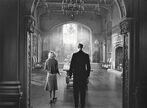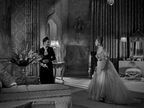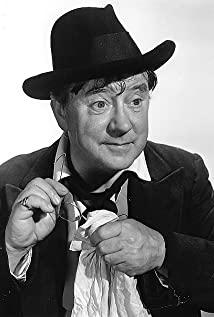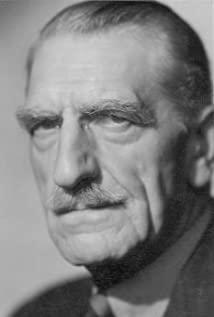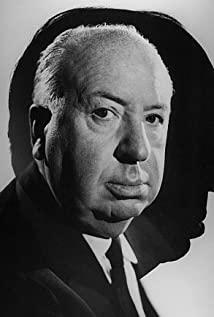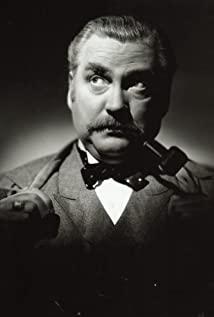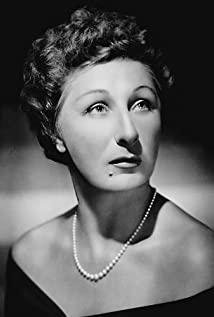——A brief analysis of the characters and the relationship between characters in "Butterfly Dream"
"Butterfly Dream" is Hitchcock's first work in the United States, and it still tells the story of the English manor. This is a romantic film full of psychological thrillers and complex relationships. It doesn't have so many conspiracies and painstaking murders, and the main contradiction is not that Fontaine is out of tune with aristocratic life, but the relationship between characters. From this level, the director pays attention to the fragility and selfishness of people, and the complexity of character relationships. What he emphasizes is not the darkness of society, but to reflect on the tumors in the normal state of society through the darkness of people. As a romantic film, there are very few scenes that are truly romantic. Hitchcock expresses the suspicion, loss, misunderstanding and asymmetry in love in a condensed and steady lens, and expresses the suspense and tension that he has always paid attention to. Combined with the local atmosphere, the film has a sharp and mysterious style. As Hitchcock has always done, three-quarters of the way out of the movie reveals part of the big picture, but revealing "who the murderer is" isn't the focus of his film at all. In The Butterfly Dream, Hitchcock deeply portrayed the four main characters, Mr. Derwent, Mrs. Derwent, Mrs. Danforth and Rebecca, and the conflicting relationship between the characters. Hitchcock portrayed the character's character to fit the rationale in the original. Integrate the appeals of the characters into the shaping of the characters, and strengthen the rationality of the promotion of the relationship between the characters. Every dialogue and scene in the film plays an important role in the relationship between the characters, the development of the plot and the creation of the atmosphere. The subtle changes in the relationship between the characters are fully explained in the light and shadow, picture composition, props, actor's demeanor, movements and details, and the characters' personalities are also vividly highlighted in it. The central characters of Hollywood movies are often a man and a woman, and this film is no different. Maxim, with a distinguished background, has the prudence and sophistication of a mature man, but he is slightly rigid, lacks wit in thick lines, and is moody and elusive. At the same time, Maxime belongs to the passive side of the overall social ideology, and he kills his ex-wife angrily like a stereotypical gentleman, albeit rationally. But the act itself reflects his anger and frustration with women he can't control. And compared to Elizabeth in Pride and Prejudice, Joan Fontaine is not a "Cinderella" in the typical sense, she doesn't even have her own name in the film (hence the heroine referred to as "Fontaine" for the rest of this article) . Cinderella can exude a confident and charming light after wearing the crystal slipper, but the panic and lack of self-confidence between Fontaine's eyebrows and eyes cannot be changed by the "crystal slipper". Nonetheless, after learning the truth, Fontaine's courage for love and a determined pursuit of happiness do resemble Cinderella. The opportunity of getting married has undoubtedly become the "crystal slipper" of Fontaine. To the entrance ticket to Mandali life. So can the "crystal slipper" really turn corruption into magic? The relationship between Fontaine and Maxime seems to be a romantic relationship that has abandoned family, but it contains complex connotations. Hitchcock deeply portrayed the asymmetry of status, instability, communication gap, and subtle discord in the relationship between the two, showing his strong control over the relationship between characters. The heroine Fontaine, the girl of the ordinary but poetic girl - used to follow, her mood is that of Derwent. I have to say that Hitchcock's casting of Joan Fontaine was very successful. Her innocent and tense performance just fits the character's weak, quiet, sad, and restless characteristics. Her expression often seemed at a loss, and her smile always had a touch of helplessness. The first is the shaping of relational asymmetry: the vague asymmetry in the love status of Maxime and Fontaine runs through the front and back. Different from arrogance and prejudice, the entangled and almost equal feelings, Maxim is always on the side with more say. It started with the phrase "eat it up like a good girl" from their first meal together. In the usual relationship between two people, Fontaine is always the one who is observant. Even at the juncture of the marriage proposal, Maxim's unshaved face hung lightly. The unequal relationship between the two is worth mentioning in the diagonal scene between Maxim and Fontaine in the seaside hut. The relationship between the characters in the picture is abnormal. Fontaine is more like prostrate on Mike's chest full of sadness and eagerness. In fact, the height difference between the two is not so disparate. This kind of positional relationship between the characters is obviously out of the characterization of the intentional relationship between the characters. It looks like Fontaine is asking for Maxim's forgiveness, but the reality is Maxim's remorse and confession. Despite his "crimes" being open and honest, he was a single-minded man who kept Fontaine on the sidelines and did not beg for forgiveness or salvation in the slightest. Only when Fontaine made it clear that he was on Maxim's side for love, did their height difference finally return to normal. This kind of relationship characterization also precisely reflects the difficult narrowing of the gap between the patriarchal background and the class at that time. In a different kind of marriage, the most likely motive—true love—is always skeptical when it’s not well-characterized, or not so “solid.” This is the key to creating a "sense of instability". It is also worth mentioning the unstable shaping of this character's emotional relationship, which Hitchcock portrays succinctly and makes it a part of the film's suspenseful color. Coupled with the character traits of the two characters, the tension in the relationship between the characters is further strengthened. Fontaine doesn't skimp on Maxime , and Maxim was always a little hesitant in expressing his emotions. In the scene where the two went for a ride together in the early days of their acquaintance, Maxime did not give a definitive answer to Fonden's question, but replied Fonden with indifference. There’s also a scene in which Maxime puts on the film, where the two men look at each other in the dark, and the director gives Maxime a close-up, half of his face shrouded in darkness, giving the character a shady tint. This made the audience further doubt his motives for marrying Vondon. It is in the scenes of emotional exchanges between the two that reconciliation is often not reached, and there are always many misunderstandings. The audience's "doubt" begins to spread, and even doubts whether the union of the two is really out of soul love. In this way, Hitchcock's purpose of requiring the audience to remain skeptical has been achieved. This instability gradually unraveled after Maxim's confession at the seaside cottage - the key to breaking and building a stable relationship is trust. Behind the scene of the two lovingly embracing before the trial is the stove in the manor. This is the burning of the inner tension and passion of the two, and it is also a symbol of hope and the reconstruction of mutual trust. It is also worth pondering the "subtle discord" that exists between the characters after this disintegration and release. Fontaine, who fainted during the trial, was helped to the car by Maxime, who asked her to eat but handed her a glass of wine. Fontaine felt sick after trying it. Such a scene brings out the subtle barriers between the characters. At the same time, the original immaturity of Fontaine and the unkind nature of Maxime were brought back, as if to say: Although the relationship between the characters has undergone major changes, those subtle contradictions still exist, and the constant existence of the characters cannot be ignored. torsion. From this point of view, the "crystal slipper" may not be able to turn decay into magic. The relationship between Fontaine and Danforth, the housekeeper, was never reconciled throughout the film, and even led to Danforth burning down Mandali Manor. Just like many film and television works, the protagonist will always encounter some unreasonable obstacles on the way to pursue a happy life. This obstruction is often tied to the subject matter of the work. In the continuation of an equally unreasonable life full of prejudice, rotten hypocrisy, and desolation, the characters tremble against this obstacle, which generates a certain poignant beauty. Danforth, who always wears a black dress, is impressive as Rebecca's "agent". In the film's handling of this character, the role of light cannot be underestimated. In the age of black-and-white films, light was of paramount importance, and the light lifted an eccentric woman with pale shadows off the screen. Even so, the character still lacks human realism. Her motives are hard to explain, we can only detect her love for Lu from details like the "black silk pajamas" Becca's unusual emotions. From her floating and gloomy eyes, the audience gradually developed a sense of alienation and discomfort towards this character. She is the agent in Rebecca's "repeated" game. In a scene in the film, the fusion of Danfoss' back and the turbulent sea deepens the connection between Danfoss and Rebecca. It was she who used "deception" to set up a barrier between Maxim and Fontaine; it was she who welded the two together, and when they both realized that the biggest enemy was actually Rebecca's shadow, they finally worked together stand up. The film repeatedly shows the contradiction between the butler Danfoss and Vondon. From the first meeting to drop the gloves, Fonden was defeated by Danforth's arrogance. In Maxim's words, "You don't act like the hostess here at all, but like a girl." In the corridor shot of Danforth and Fontaine visiting the room together, the director uses a medium shot to shoot the back of the character, the corridor in the corridor. The background enhances the depth of the shot. Although Fontaine walks in the front, it is located in the corner of the corridor, while Danfoss is located in the middle of the corridor although it is in the back. From the whole picture, Fontaine's weight is very small, and the relationship between the characters is shown in this orderly form. In many scenes of confrontation between two people, the director often uses close-up and symmetrical composition. Although the two occupy the same proportion of the picture, almost every time Fontaine leans on the object, holding his chest in panic. All of these shots show the intense oppression of one character over another. It was only in the final confrontation that the situation changed. Danforth was interrogated to tell the scene of the doctor's residence. Fontaine and Maxime were next to each other, fighting against the shadow of Danforth in Rebecca. This is the second refactoring point of their trust. This time, Fang and Deng are no longer alone with Mrs. Danforth. In this confrontation, in a way, Danfoss lost. And a character who has never appeared but is ubiquitous - Rebecca, the director did not even want to reveal a photo, but used a lot of props to shape her - letters, various objects embroidered with her name , and even a prop-like image of a black dog, Benn appeared. If Rebecca, even a photo, was featured in the film, the character's mystical power would be greatly diminished. "Having both upbringing and beauty." Almost everyone's profile description of rebecca is perfect, which makes people suspicious. Various abnormal characters also make the truth more confusing. The relationship between Mr. Derwent and Rebecca gradually shows signs as the plot goes on. Every time something related to Rebecca is mentioned, Derwent always looks more annoyed than sad. As the main obstacle in the relationship between Fontaine and Maxime and the characters, Rebecca's most direct The intervention is carried out through the "agent" Danfoss. Its motives stem from mockery of true feelings, contempt for commoners, and selfish jealousy. Although Rebecca has no affection for Maxime, it is easy for audiences to believe that if she were to come back to life, she would use a "cultured" gesture to inflict ridicule, contempt and jealousy on Fontaine. But from another angle, the trauma that Maxime received at Rebecca has become one of the important reasons why his love with Fontaine can arise. And in the process of confrontation, the two sides constantly refreshed their understanding of each other. We don't know what happened to Rebecca in the past. The selfishness, hypocrisy and emptiness in her is the rotten side of high society. She thinks that she can play with people's hearts, but she is just looking for fun in the form of patriarchy, and it is embarrassing to spend the meaning of life on emptiness and indulgence. Again, the crystal slipper has never been the key to changing Cinderella. In this play, the character relationship is the turning point of "Cinderella". Only the emerging "new life" can make this gray castle fade away. So, is there really happiness at all? People outside the castle want to go in, but people in the castle are still lonely. The mandala disappeared like a dream, is there anything left? Years later, I will still remember the scene of panicking away at a fancy dress party wearing a white dress. Looking at the back, it looks like the figure of Cinderella leaving hurriedly after midnight at the dance!
View more about Rebecca reviews




